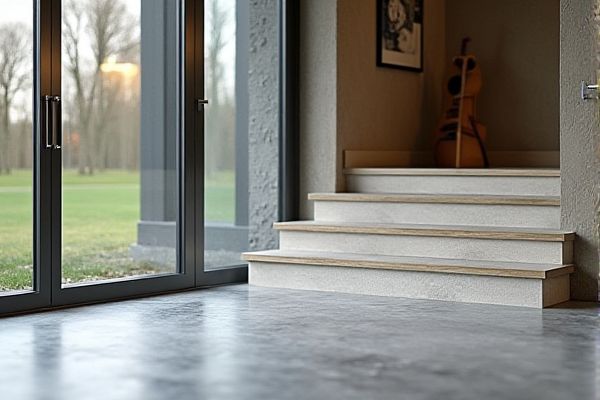
Steel edging offers superior durability and a sleek, modern appearance, making it ideal for long-lasting garden borders and pathways, while plastic edging is lightweight, budget-friendly, and easier to install for temporary or smaller landscaping projects. Explore the rest of this article to discover which edging option best suits your landscaping needs and enhances your outdoor space.
Table of Comparison
| Feature | Steel Edging | Plastic Edging |
|---|---|---|
| Durability | Highly durable, rust-resistant varieties available | Moderate durability, can crack under pressure or UV exposure |
| Cost | Higher upfront cost | Lower cost, budget-friendly |
| Installation | Requires tools and effort, heavier | Easy to install, lightweight |
| Appearance | Sleek, modern look, blends with metal features | Variety of colors, can fade over time |
| Flexibility | Less flexible, best for straight or gently curved edges | Highly flexible, suits complex curves |
| Environmental Impact | Recyclable, longer lifespan reduces waste | Often made from non-recyclable plastics |
| Maintenance | Low maintenance, may require rust prevention treatment | May need replacement if cracked or faded |
Introduction to Landscape Edging Materials
Steel edging offers superior durability and a sleek, modern appearance, making it ideal for defining garden beds and pathways with clean, sharp lines. Plastic edging provides a flexible, cost-effective solution suitable for curved designs and easy installation but may lack the longevity and strength of steel. Your choice depends on the desired aesthetic, budget, and long-term maintenance considerations within your landscape project.
Overview of Steel Edging
Steel edging offers superior durability and strength compared to plastic edging, making it ideal for defining garden beds, pathways, and driveways with lasting precision. Its resistance to weathering, UV rays, and physical impact ensures long-term performance without warping or cracking. Steel edging's sleek profile provides a clean, modern aesthetic while maintaining flexibility for curved or straight landscaping designs.
Overview of Plastic Edging
Plastic edging offers a lightweight, flexible alternative to steel edging, ideal for creating smooth, curved garden beds and pathways. Its durability resists moisture and corrosion, requiring minimal maintenance compared to metal options. You can easily install plastic edging yourself, benefiting from its affordability and adaptability in various landscaping designs.
Durability: Steel vs. Plastic Edging
Steel edging offers superior durability compared to plastic edging, resisting cracking, warping, and UV damage over time. Plastic edging tends to degrade under extreme weather conditions, becoming brittle and less effective within a few years. Choosing steel edging ensures your landscaping maintains a clean, long-lasting boundary that withstands heavy use and environmental stress.
Installation Process Comparison
Steel edging offers a straightforward installation process, requiring stakes to be driven into the ground and edges to be bent or cut to fit your landscape shape, providing a durable and long-lasting barrier. Plastic edging is generally easier to install with flexible strips that snap together and are secured using spikes, making it suitable for DIY projects but less robust in extreme weather conditions. Your choice depends on whether you prioritize the strength of steel or the convenience and flexibility of plastic during installation.
Aesthetic Appeal and Design Options
Steel edging offers a sleek, modern aesthetic with sharp lines that enhance contemporary garden designs, providing durability and a polished finish. Plastic edging presents versatile design options with various colors and flexible shapes, ideal for curvilinear landscapes and budget-conscious projects. Both materials can define garden beds effectively, but steel's minimalistic look contrasts with plastic's adaptability in creative layouts.
Maintenance Requirements
Steel edging requires minimal maintenance due to its durability and resistance to warping, cracking, and UV damage, making it ideal for long-term garden borders. Plastic edging is more prone to damage from sun exposure and may warp or become brittle over time, necessitating periodic replacement or repairs. Regular inspection and occasional cleaning are needed for both, but steel edging offers a more resilient and maintenance-efficient option for landscape management.
Cost Analysis: Steel vs. Plastic
Steel edging typically commands a higher upfront cost compared to plastic edging due to its durability and longevity, making it a cost-effective option over time for projects requiring long-lasting borders. Plastic edging, while more affordable initially and easier to install, may incur replacement costs more frequently due to its susceptibility to cracking and UV damage. When evaluating your landscaping budget, considering factors like maintenance expenses and lifespan will help determine the best financial investment between steel and plastic edging.
Environmental Impact Considerations
Steel edging offers higher durability and recyclability, reducing landfill waste and resource consumption over its lifespan compared to plastic edging, which often contributes to microplastic pollution and has limited recyclability. Plastic edging, made from petroleum-based materials, poses environmental risks through chemical leaching and slower decomposition rates, impacting soil and water quality. Choosing steel edging supports sustainable landscaping by minimizing environmental footprint and promoting circular economy practices.
Choosing the Right Edging for Your Landscape
Steel edging offers durability, a clean modern look, and superior strength for high-traffic or heavy soil areas, making it ideal for long-term landscape projects. Plastic edging is cost-effective, flexible, and easier to install, perfect for curved garden beds or temporary borders in softer soil conditions. Your choice depends on the landscape's design, maintenance preferences, and exposure to environmental factors.
 homyna.com
homyna.com